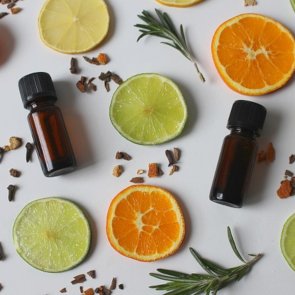3 Tips for Making Your Own Essential Oil Blends
 Essential oils have been used for therapeutic and cosmetic purposes since ancient times. Although there is no good medical evidence that the smell of essential oils can cure diseases, it surely has a positive effect on our psycho-emotional state. To benefit more from aromatherapy, you can blend essential oils together so that they complement one another. However, it is important to know how to do this right.
Essential oils have been used for therapeutic and cosmetic purposes since ancient times. Although there is no good medical evidence that the smell of essential oils can cure diseases, it surely has a positive effect on our psycho-emotional state. To benefit more from aromatherapy, you can blend essential oils together so that they complement one another. However, it is important to know how to do this right.Essential oils can work together in harmony, balancing out each other’s weaker parts and highlighting stronger ones. However, some oils don’t work together well and even clash; blending them can lead to headaches and other side effects. Before combining essential oils, you need to understand for what purpose you’re doing this and learn the basic rules of blending. Here are several tips that may be helpful.
Group Aromas by Scent Type and Effect
All essential oils can be grouped into categories according to their scent. This categorizing is rather loose, but it helps understand which oils generally work together and which don’t. The six common scent types are floral (flowery), citrus, woody, earthy, herbaceous (herbal), and spicy.
- Floral: ylang-ylang, vanilla, rose, palmarosa, lavender, jasmine, geranium.
- Citrus: tangerine, petitgrain, orange, neroli, lime, lemongrass, lemon, grapefruit, citronella, bergamot.
- Woody: vetiver, sandalwood, patchouli, myrrh, juniper, frankincense, fir, cypress, cedarwood.
- Earthy: oakmoss, angelica root.
- Herbaceous: thyme, tea tree, sage, rosemary, peppermint, oregano, marjoram, eucalyptus, clary sage, chamomile, basil.
- Spicy: pepper, nutmeg, ginger, clove, cinnamon, cardamom, aniseed.
Some oils belong to more than one scent type, for example, coriander (woody and spicy), neroli (floral and citrus), patchouli (woody and earthy), vetiver (woody and earthy), and some others. Generally, oils that belong to the same type blend well together.
Another aspect you should pay attention to is the type of effects essential oils have. For example, there are energizing oils and calming oils. If you mix oils from these two groups, they will negate each other’s effects. On the other hand, blending oils that are within the same category or belong to similar categories (for example, calming and anti-anxiety) usually works well. Here are the most popular essential oil categories:
- Aphrodisiac: black pepper, cinnamon, ginger, jasmine, patchouli, rose, sandalwood, ylang-ylang.
- Anti-anxiety: bergamot, black pepper, geranium, jasmine, lavender, lemon balm, marjoram, orange, roman chamomile, sandalwood, tangerine, valerian.
- Calming: geranium, jasmine, lavender, lemon balm, mandarin, neroli, palmarosa, patchouli, petitgrain, sandalwood, ylang-ylang.
- Detoxifying: grapefruit, hyssop, juniper, laurel, lemon, mandarin, patchouli, peppermint, rosemary.
- Energizing: basil, bergamot, clary sage, cypress, eucalyptus, ginger, grapefruit, lemon, lemongrass, pine, peppermint, rosemary, spearmint, tea tree.
Take Baby Steps
Even if you choose oils from the same group, you may discover that you don’t like them together. When experimenting with blending essential oils, it’s wise to take baby steps. First of all, don’t try to mix too many essential oils. Start with just two and gradually progress to creating more complex essential oil blends as you begin to the get hang of it. Generally, blends contain 2 to 5 essential oils; more can be an overkill.
During experimenting with your first blends, use just 10 drops or so. If everything turns out well, you can always create more of the blend using the same proportions; if you aren’t satisfied with the result, you’ll still have enough of oils left to experiment more. Some essential oils can be quite expensive, so using too much oil on your first try definitely isn’t the best idea.
Trust Your Instincts
Although it is important to learn about the properties of essential oils and the rules of blending them, your instincts matter just as much as the theoretical base. If you like two particular oils and feel like they’re meant for each other, go for it! Even if it turns out you were wrong about this, you never know till you try.
Keep in mind that it will take the oils some time to blend well and harmonize with one another. So don’t try to sniff your blend immediately. Close the bottle and let it rest for a day or two before giving the blend the final sniff test.